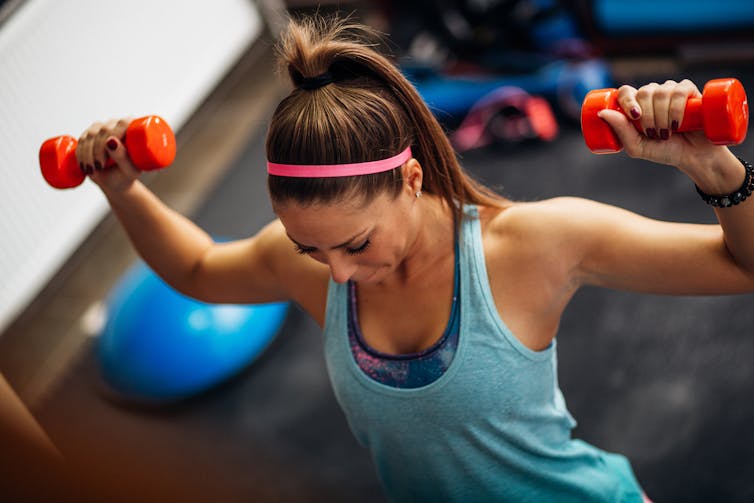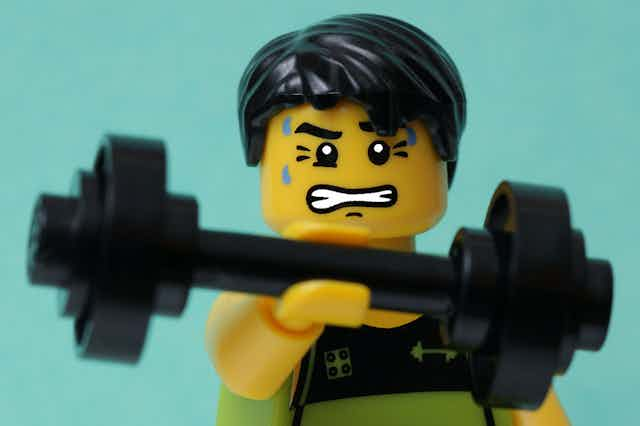Regular participation in muscle strengthening activity such as weight or resistance training has many health benefits. However, this mode of exercise has been largely overlooked in Australian health promotion. Our recent research shows a large majority of Australians do not engage in muscle strengthening activity.
Muscle strengthening activity usually includes exercise using weight machines, exercise bands, hand-held weights, or own body weight (such as push-ups or sit-ups). When performed regularly, muscle strengthening activity leads to the improvement or maintenance of strength, size, power and endurance of skeletal muscles.
Historically, most public health physical activity recommendations have predominantly promoted moderate to vigorous intensity aerobic physical activity (such as brisk walking or jogging). However, the current Australian guidelines issued in 2014 are our first national public health guidelines to additionally recommend muscle strengthening activity. They recommend an adult “do muscle strengthening activities on at least two days each week”.
This addition of muscle strengthening activity into the physical activity recommendations is due to emerging scientific evidence linking this type of activity to reduced risk of type 2 diabetes, high blood pressure, weight gain, physical disability, heart disease, poor musculoskeletal and mental health and premature death.
Among the most important roles muscle strengthening activity has is enabling older adults to keep their physical functioning adequate, preventing or delaying frailty and falls, and thus maintaining independent living for longer.

Importantly, when compared to aerobic physical activity such as walking and cycling, weight training has greater benefits for bone/joint health, the ability to perform activities of daily living (general mobility, getting into and out of a chair, bathing, dressing) and slowing the loss of skeletal muscle mass/strength. These outcomes are very important for all age groups, especially for older adults as we seek ways to maintain their independence.
Given the potential health benefits of muscle strengthening exercise, surprisingly little was known about participation in such activities among Australians. To gain a better understanding of the levels and patterns of muscle strengthening activity among the Australian population we analysed two national surveys: the Australian Bureau of Statistics: National Nutrition and Physical Activity Survey (2011-12); and the Australian Sports Commission: Exercise, Recreation and Sport Survey (2001-10).
The key findings were that only 9% - 19% of Australian adults meet the muscle strengthening activity guidelines; over 80% of adults report no muscle strengthening activity; participation rates decline with age, being two to four times lower among older adults when compared to young adults.
Participation in muscle strengthening activity is socioeconomically and geographically patterned. When compared to those from less disadvantaged and metropolitan areas, those from more disadvantaged and regional/remote areas are less likely to participate in muscle strengthening activities.
How to get people pumping
Participation rates might be so low because engagement in muscle strengthening activity usually requires some basic exercise knowledge. Access to equipment is almost certainly complicating its uptake. Sticking to the exercise over time could be difficult for those with limited or no experience.
Another barrier might be the potential for negative social comparisons. It’s possible many think muscle strengthening activity is associated with excessive muscle gain, risk of injury, “hyper-masculine” settings (gymnasiums) and with the somewhat fringe modes of this activity (such as strongman competitions, bodybuilding, CrossFit).
It is known that when performed correctly, muscle strengthening activity is safe, and large gains in muscle mass are likely to be limited to extreme participation levels.
If you are currently doing no muscle strengthening activity, even small increases are likely to have health benefits. Some practical tips for getting started are to begin with body weight exercises like squats, sit-ups, or push-ups at home; do household chores that involve digging, carrying, or lifting; and join a gym to do weights or other strength training.

